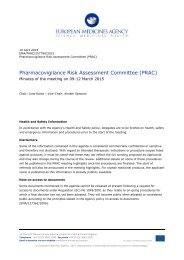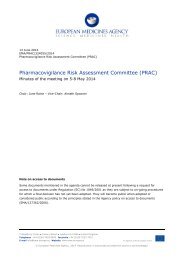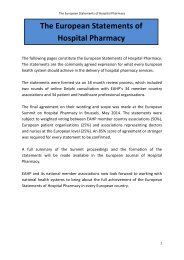WC500165698
WC500165698
WC500165698
You also want an ePaper? Increase the reach of your titles
YUMPU automatically turns print PDFs into web optimized ePapers that Google loves.
Taken together, the available evidence indicated that, in some patients, goserelin can cause flushing<br />
and hyperhidrosis that persist after cessation of treatment and for a period of time that is longer than<br />
expected. The PRAC agreed that this should be reflected in the product information.<br />
Summary of recommendation(s)<br />
<br />
<br />
The MAHs for the reference, nationally authorised goserelin-containing medicines 9 should be<br />
requested to submit to the NCA within 60 days a variation to update the product information to<br />
include that hyperhidrosis and hot flushes may continue after stopping the treatment.<br />
The MAHs of generic products should then be requested to submit to the EMA or to the NCA, as<br />
applicable, a variation to align their product information to that of the originator.<br />
For the full PRAC recommendations, see EMA/PRAC/144622/2014 published on the EMA website on<br />
24/03/2014.<br />
4.3.3. Quetiapine (NAP)<br />
<br />
Signal of suicidality in major depressive disorder (MDD) patients<br />
Regulatory details:<br />
PRAC Rapporteur: Sabine Straus (NL)<br />
Administrative details:<br />
Procedure scope: Evaluation of the MAH’s responses to PRAC recommendation as adopted at PRAC in<br />
October 2013<br />
EPITT 17709 - Follow-up October 2013<br />
MAH(s): various<br />
Background<br />
For background information, see PRAC minutes of 7-10 October 2013. The MAH replied to the request<br />
for information on the signal of suicidality in major depressive disorder (MDD) patients and the<br />
responses were assessed by the Rapporteur.<br />
Discussion<br />
The PRAC discussed the interpretations of the results of the previously discussed General Practice<br />
Research Database (GPRD) study which was compared with the PHARMO, an epidemiological study<br />
which was completed in 2011. Furthermore data from other studies, in particular the results of a<br />
prescription-event monitoring study concluded at the end of 2013 (mPEM), and the clinical trial<br />
database were also reviewed. The PRAC discussed the strength and limitations of the evidence<br />
provided and agreed that overall there was a higher mortality rate in Seroquel XR (quetiapine) user<br />
groups, especially in MDD patients; however confounding by indication might explain at least part of<br />
these findings.<br />
A higher mortality rate in elderly patients with dementia in comparison with elderly without dementia<br />
was also observed according to the data submitted. However, no clear conclusions can be drawn at the<br />
moment based on the currently available data on both populations. The PRAC noted that, currently,<br />
9 In line with Article 16(3) of Regulation No (EU) 726/2004 and Article 23(3) of Directive 2001/83/EC, the marketing<br />
authorisation holder shall ensure that the product information is kept up to date with the current scientific knowledge<br />
including the conclusions of the assessment and recommendations made public by means of the European medicines webportal<br />
established in accordance with Article 26 of Regulation (EC) No 726/2004 (EMA website). For nationally authorised<br />
medicines, it is the responsibility of the National Competent Authorities of the Member States to oversee that these<br />
recommendations are adhered to<br />
Pharmacovigilance Risk Assessment Committee (PRAC)<br />
EMA/PRAC/253432/2014 Page 21/64








